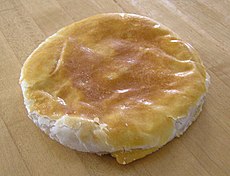Sweetheart cake
 | |
| Alternative names | Wife cake, Laopo bing |
|---|---|
| Course | snack, dessert |
| Place of origin | Guangdong, China |
| Region or state | Cantonese-speaking areas |
| Main ingredients | winter melon, almond paste, sesame, five spice powder |
| Sweetheart cake | |||||||||||||||||
|---|---|---|---|---|---|---|---|---|---|---|---|---|---|---|---|---|---|
| Traditional Chinese | 老婆餅 | ||||||||||||||||
| Simplified Chinese | 老婆饼 | ||||||||||||||||
| Literal meaning | wife ("sweetheart") cake | ||||||||||||||||
| |||||||||||||||||

A sweetheart cake or wife cake is a traditional Cantonese pastry with flaky and thin skin made with winter melon, almond paste, and sesame, and spiced with five spice powder).[1] "Wife cake" is the translation of lou po beng from Cantonese, and although the meaning is "wife," the literal translation is "old lady cake," paralleling the colloquial usage of "old lady" for "wife" in American English.
The cake is still popular among many in Hong Kong and Mainland China. Many people in Hong Kong, as well as professional chefs, also bake "modern" varieties of this cake.
Versions
The orthodox version is from the Guangdong-Hong Kong region, where filling consists of wintermelon made by the process of candying.[2] The candied mash is then combined with white sesame seeds and glutinous rice flour.[3] Coconut in the form of mash or desiccated shreds and almond paste as well as vanilla is also sometimes added.[4] The authentic flavour and flaky texture of the pastry is produced by the usage of pork lard shortening [5] then by glazing with egg wash.[6] Due to its rising popularity in Western countries brought about by immigration, butter is sometimes substituted in place of lard, however the taste is altered.[7] The level of sweetness is mild, compared to Western sweet pastries.
South-east Asian variations can include spices such as Chinese five spice. However, although this spice is of Chinese origin, it is never used in authentic Sweetheart cake. This may be confused with the Husband cake, which uses star anise in its filling.[8]
Legendary origin
There are many legends that attempt to explain the origins of the Sweetheart cake. One tells the tale of a couple that lived a very poor life, in imperial China. They loved each other and lived in a small village. Suddenly, a mysterious disease spread. The husband's father became very sick. The couple spent all of their money in order to treat the man's father, but he was still sick. The wife sold herself as a slave in exchange for money to buy medicine for her father-in-law. Once the husband learned about what his wife did, he made a cake filled with sweetened wintermelon and almond. He dedicated this pastry to his wife, whom he could never forget, and sold it in the street. His cake became so popular that he was able to earn enough money to buy his wife back.[9]
There is another version where the man went searching for his wife after he earned enough money to buy her back. In his search, he had a cup of tea at a local teahouse, when he suddenly recognised the pastry they were serving with the tea. They were reunited at the teahouse.
Another story tells of a dimsum chef's wife creating a pastry with wintermelon paste influenced by a recipe from her mother's family. The new pastry was found to taste better than the dimsums that were being sold in teahouses and the chef proudly told everyone it was made by his wife, hence it was named "Wife Cake".[10]
See also
- Chinese bakery products
- List of Chinese desserts
- List of desserts
- List of pastries
- Marry girl cake
 Food portal
Food portal
References
- ^ Chinese-sweetheart-cake
- ^ "How to make Candied Winter Melon aka Tung Kua(冬瓜糖)". 2009. Retrieved 18 December 2011.
{{cite web}}:|first=missing|last=(help) - ^ "Chinese Wife Cake Recipe". 2006.
- ^ "Wife Biscuit/Sweetheart Cake". 2010. Retrieved 18 December 2011.
- ^ "40 Hong Kong foods we can't live without". CNN International. 2010. Retrieved 18 December 2011.
- ^ "Wife Biscuit/Sweetheart Cake". 2010. Retrieved 18 December 2011.
- ^ "Cantonese Pastries: Husband and Wife Cake". Lifeofguangzhou.com. 2008. Retrieved 18 December 2011.
- ^ "Cantonese Pastries: Husband and Wife Cake". LIfeofguangzhou.com. 2008. Retrieved 18 December 2011.
- ^ "Cantonese Pastries: Husband and Wife Cake". Lifeofguangzhou.com. 2008. Retrieved 18 December 2011.
- ^ Jacky Yu. "Food Story". Retrieved 18 December 2011.
